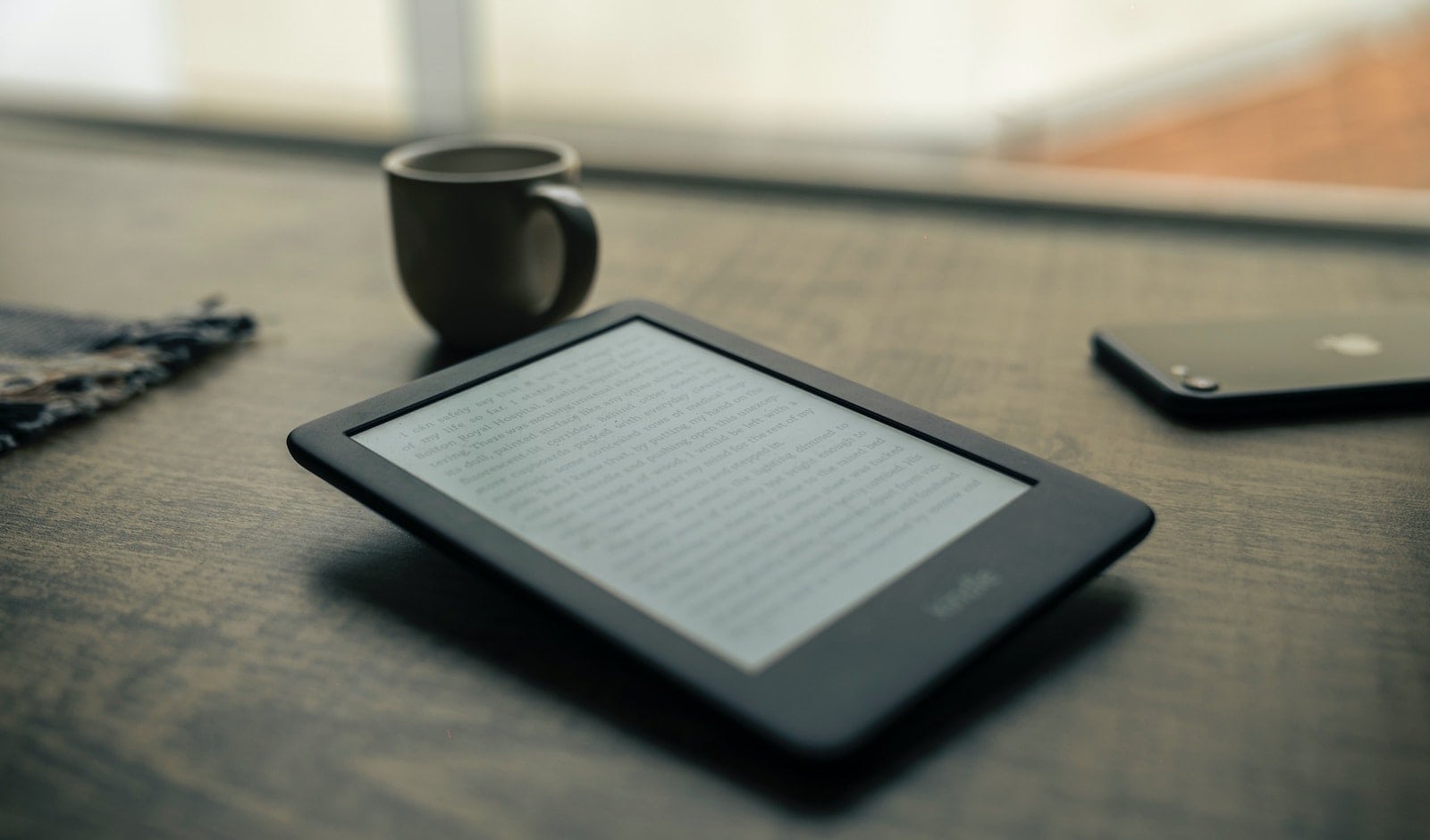
Have you ever read a book, taken a course, or attended a talk and thought, “this is great!” but then… never thought about the content again?
Or maybe you have so many books in your “To Read” pile that you feel guilty you will never get to them all, or you never know what book to read next, which causes you to lose the reading habit.
Or perhaps you have started to feel “out of balance” because you only read productivity books, business books, fiction books, or insert book type here.
Maybe you come across a problem, and you know you’ve read something or been in a conference session that would help, but you can’t remember where it was.
Or the worst: you buy a book, start reading it, and realize partway through, “wait a minute, I’ve already read this!”
All of these are situations I have faced in the past, and chances are many of you have.
Over the years, I have developed a system that eliminates all of these problems. I have mentioned it from time to time on The Productivity Show podcast but have never outlined the whole thing in one place — until now.
Not Just For Books
The main focus will be books, but parts of this system can apply to anything. I will show examples from conference notes, but it could apply to meeting notes, conference notes, podcasts, videos, anything you want to capture, review, and resurface.
Why Bother With A Reading, Recording, And Review System?
After all, we are talking about reading and taking notes here. It’s not rocket science. You don’t need to overcomplicate everything, Brooks.
You don’t need a system to read and take notes. You can just… do it.
However, I have found my system meets four goals:
1. Identify What To Read: Book recommendations are everywhere. They come up in conversation, on podcasts, in online communities — it’s constant. Having a defined place to put those recommendations will ensure you don’t forget them and save you from recency bias — it is easy to only read the new and “hot” books and neglect more timeless ones. Even better if (spoiler alert) you structure your list in a way that helps you balance the types of books you read.
2. Capture Key Points: This doesn’t apply to all types of books, but in many cases, there is information from the book, conference, webinar, or whatever you are consuming that you want to remember later. You want an easy way for you to capture it.
3. Identify Action Items: Is there something you want to do due to what you just read or heard? Maybe you want to research something. Perhaps you want to buy another book. It could be you want to implement a new process in your team. You want to make sure you take action — otherwise, what’s the point?
4. Remember and Resurface: Unless you have a photographic memory, you will almost certainly forget most of what you just read or heard. How can you remember this information, and make it still useful even years from now?
The Tools
You don’t need fancy tools for any of this. Even a paper notebook will work well.
However, here is what I use and why. There is nothing magical about any of these tools — feel free to substitute anything you like better.
1. A list app: I keep my “To Read” list(s) in a simple list app. Since I am in the Apple ecosystem, I just use the Reminders app in iOS and macOS. I like it because it is simple, integrates with everything, and seamlessly syncs between all my devices.
2. A mind mapping app: My chosen format for most notes is a mind map. We have talked about mind maps for many years. They are great for building habits and generating ideas, and I find they work best for capturing book and conference notes. I use MindNode, which is Apple only. Mindmeister is a popular cross-platform web tool. If you prefer to take notes in something like Obsidian, Word, Google Docs, or even by hand: go for it!
3. Somewhere to store your notes: My book and conference notes typically end up in Evernote, which I have used since 2008. It doesn’t matter where you store them, as long as it is easy to save your notes and has decent search.
4. A task manager: You need somewhere to put action items that come out of what you are reading or hearing. I use OmniFocus, but Todoist or even a Bullet Journal are great too.
BONUS: Some automation: This is not even remotely required, but it wouldn’t be an article from me without some automation thrown in. Later in the article, I’ll share how I automate some of this.
How I Choose And Track What Books To Read
As I said before, book suggestions are everywhere. My rule is this: If someone I respect recommends a book, I capture it. I may or may not ever read it (more on that later), but I want it on the list.
Many people have a “To Read” list, but I do things a little differently.
There was a time in my life that I found myself only reading productivity and business books. It wasn’t a conscious choice, but I guess I felt I had to be “efficient” or “productive.”
Then one day, I was in London at a Covent Garden book store waiting for my wife. I was standing in front of the employee recommendation shelf, and whatever the employee wrote about Norwegian Wood by Haruki Murakami grabbed me for some reason, and I bought it.
My subsequent Murakami wild sheep chase reminded me of my love for fiction. Then listening to a Robert Caro book made me re-fall in love with biographies, and I realized I wanted to be more balanced in my reading.
Many people keep a “To Read” list, but I decided to keep three:
- Fiction
- Non-Fiction
- Biography
Here are my lists at the time of writing this article:
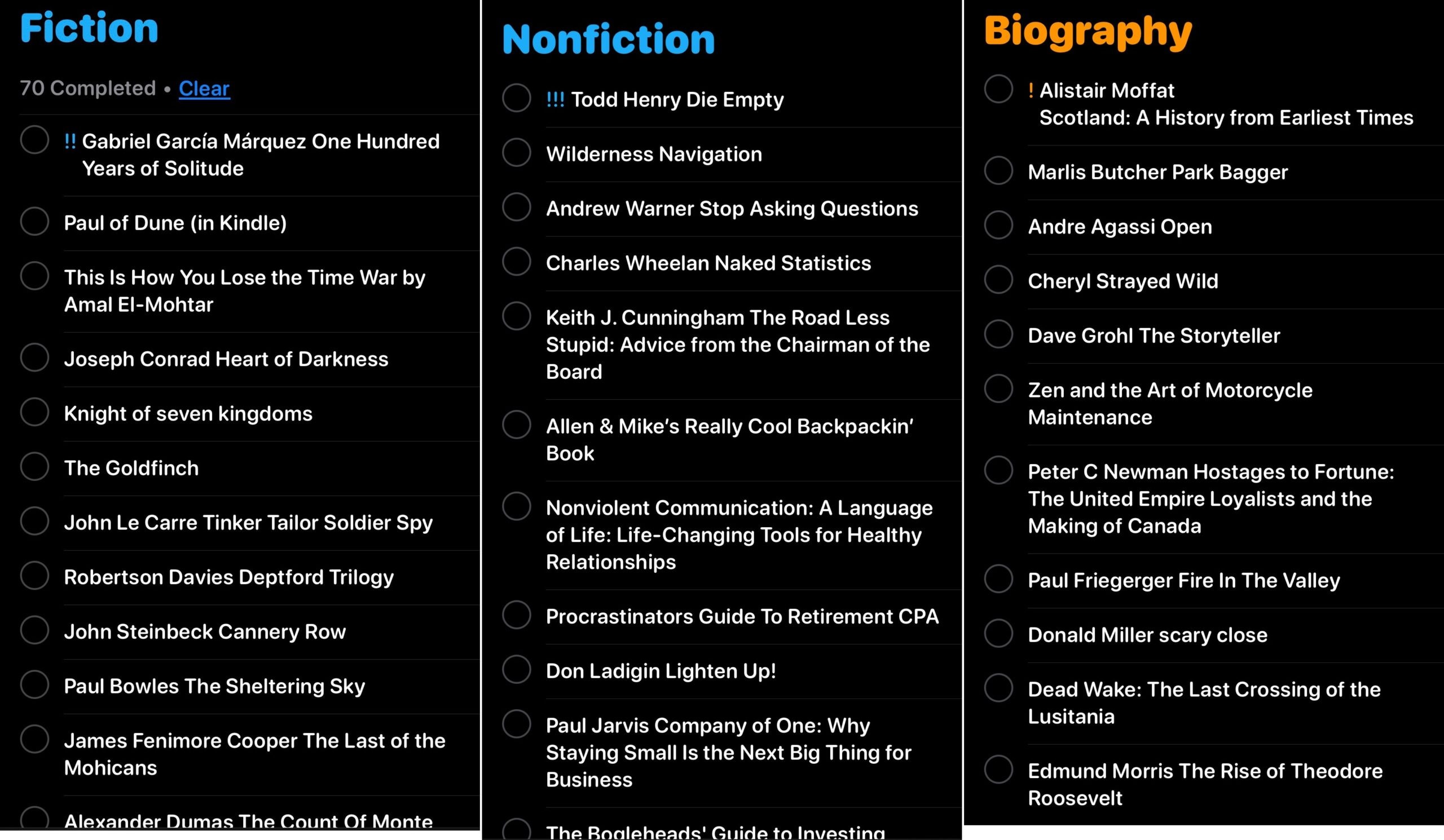
When I read, I cycle through these three categories. So going by the image above:
- I am currently reading Scotland: A History from Earliest Times (stretching the definition of “Biography” I admit)
- Next will be Die Empty: Unleash Your Best Work Every Day
- After that will be One Hundred Years of Solitude
- And then will loop back to next up on the Biography list
I have been doing this for years, and I love it. I never get into “reading ruts” or get burned out.
When I come across a book, usually it goes to the end of the list unless it is something topical or time-sensitive, then I might slot it in near the top
This system is a guide, not a straight jacket. If I don’t feel like reading what is next, I change it up.
Thanks to these lists, I never need to think about what comes next. I have the next one ready to go when I am nearing the end of a book. That way, there is no chance of me dropping the reading habit.
A Note About “Book Guilt”
Recently, in the live stream chat for one of our free presentations, we got on the subject of books, and one of the attendees said this:
I’ll be happy if I ever get to a steady state where my “to read” pile doesn’t grow faster than my “have read” pile.
I get that feeling. Once you put something on a “to read” or a “to watch” list, it feels like an obligation, but it is a feeling I have learned to let go of.
Currently, my Fiction list has 85 books on it, my Biography list has 199, and my Nonfiction list has 248. I will likely never read all those books, especially when you include new ones coming onto the list.
Guess what? It’s ok. I think of the books on my To Read lists as “suggestions” rather than “tasks.” It’s a subtle mindset shift but very freeing.
How I Take Notes
When I take notes from a book, webinar, or conference session, I am trying to do two things:
- Can I distill what the book or session is about? If I come back to read this later (hint, hint), can I follow through the main points and ideas?
- Is there anything actionable I want to follow up on as a result of this material?
Of course, I don’t take notes from every book:
- Fiction: never. They’re like a brain break for me.
- Biographies: almost never. If anything, I will just capture action items directly to a task manager.
- Non-Fiction: Often. Not every book lends itself to being revisited. It’s a case-by-case decision.
There is no “right way” to take notes. Some people like to mark up paper books or write their own indices. Some people like to highlight in the Kindle app and export using a tool like Bookcision.
Some people like to handwrite notes to enhance memory, as there is evidence that handwritten notes involve more cognitive engagement, which leads to deeper understanding and enhanced learning.
I have no doubt that is true, but I am pragmatic: there is no way I will handwrite notes for books that I read. It just won’t happen. But I will mind map, so that is what I do.
You need to figure out what works best for you.
As I read a book, I will take notes in a mind map, either on my iPad or even my phone. Whichever is handy. I use a focus mode on my devices to not be distracted, which works well.
For example, here is a sample mind map with my notes from Peak: Secrets from the New Science of Expertise. (You can download the entire mind map here.)
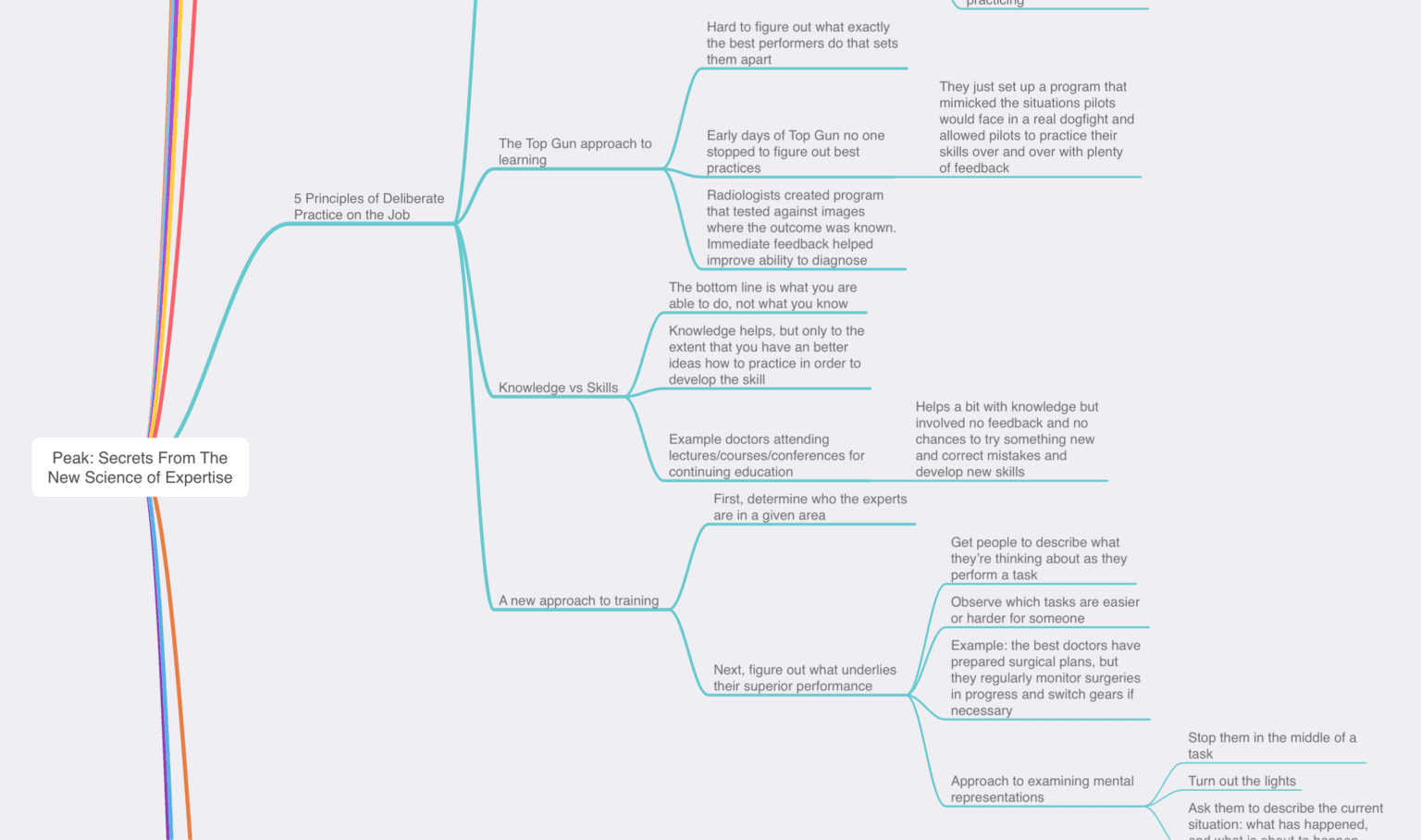
Sometimes I get fancy and use emoji or images when chapters are broken into sections or themes, as you can see here in my notes from Get Together: How to build a community with your people. (You can download the entire mind map here.)
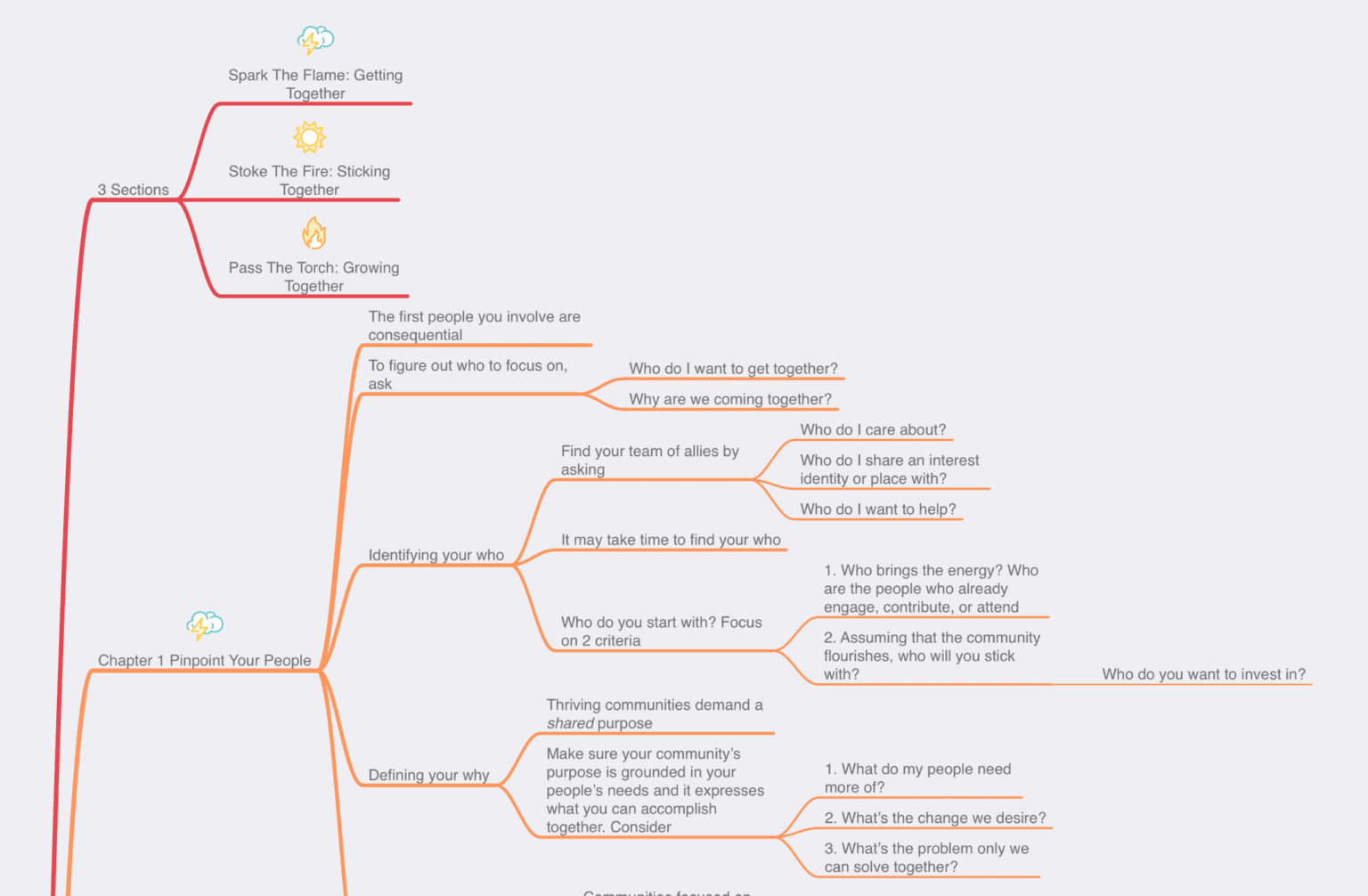
One benefit of using my devices for this is when there is a diagram, table, or other passage that I want to capture, I can embed the image right in the mind map:
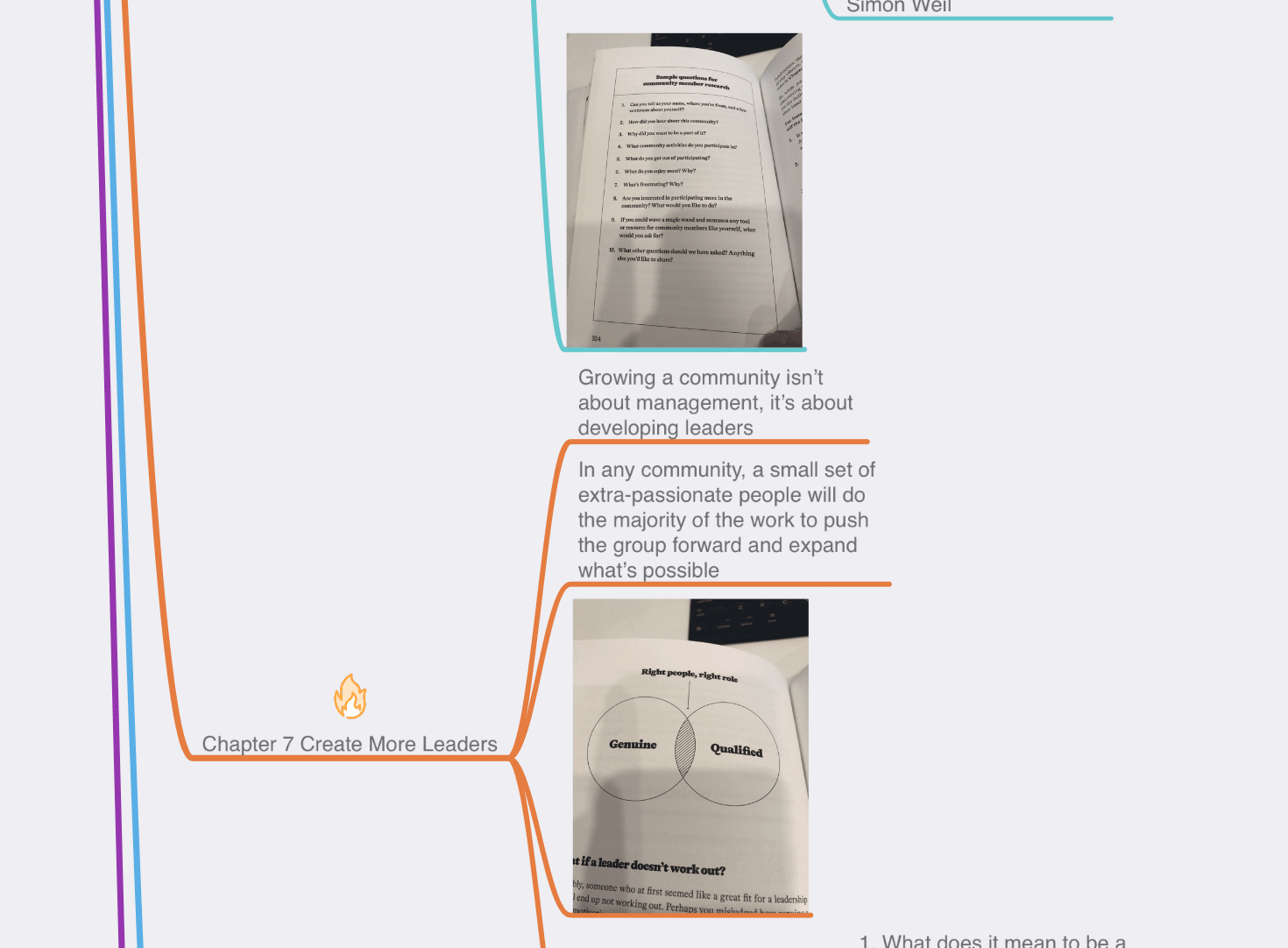
Sometimes, a mind map doesn’t work: for example, in a meeting or conference it may not be appropriate (for me) to use a device. In that case, I jot down my notes as our forefathers did: using a Pilot G2 .38mm pen.
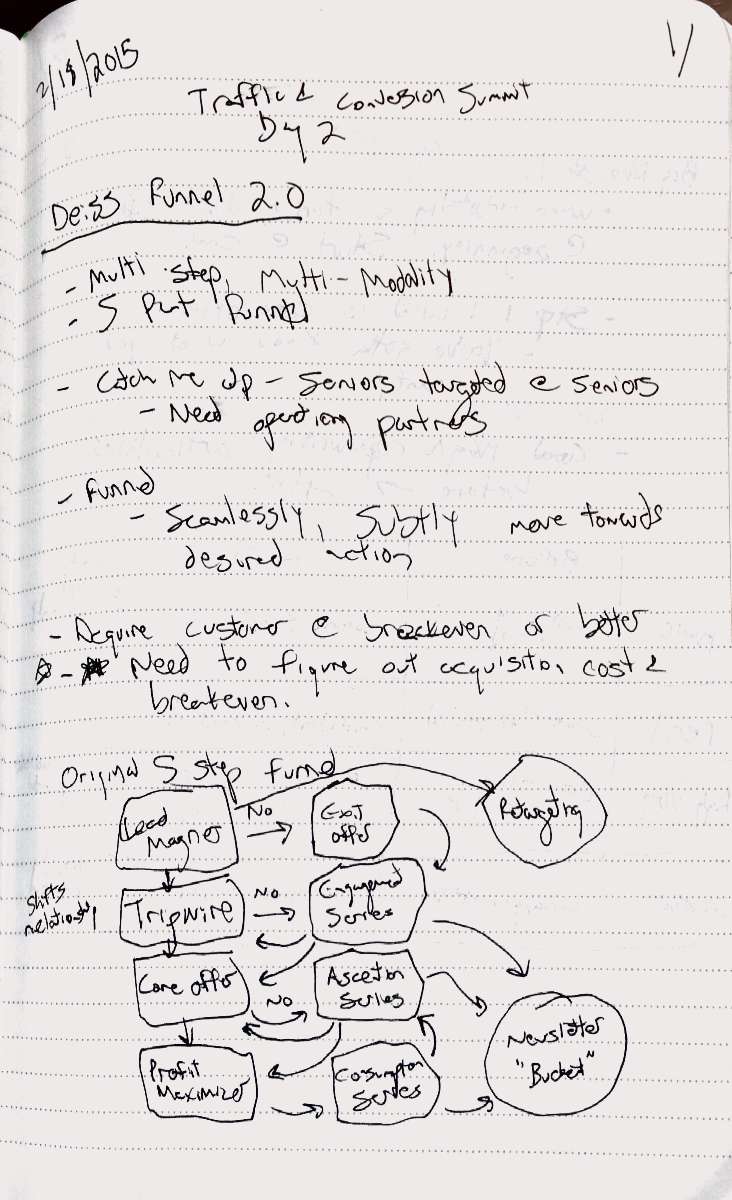
Taking notes is one thing, but the key to all of this is to save them in a place you can easily find them again.
The Curious Case of Audiobooks
I mostly read paper or Kindle books, but I always have an audiobook going when I’m alone in the car.
I used to listen to sports radio in the car, but years ago I had an epiphany: why am I spending 30 minutes of my life listening to two blowhards argue over whether some 20-year-old millionaire should be a 2nd or 3rd line defensemen for the Vancouver Canucks? It just doesn’t make any sense (for me).
At that moment, I decided: if I am driving alone in the car, I will always listen to an audiobook, either from Audible or the library via the Libby app.
You will not be surprised to learn I have a system for that too: I have an “Audible” list and alternate between extremely long detailed biographies and short business-y type books.
However, audiobooks in the car are a problem: if you are a safe driver, you can’t give them full attention. And how do you take notes? Sure, you can use voice recognition and other tricks, but I don’t bother.
Here’s what I realized: if it is a popular book, chances are someone out there has written up a summary PDF, or a blog post, or review, or something that will at least get the gist and key points of the book.
So for audiobooks, I don’t worry about creating my own notes. I capture existing summaries. For example, here is a great one for Ultralearning: Master Hard Skills, Outsmart the Competition, and Accelerate Your Career from Nils at NJlifehacks.
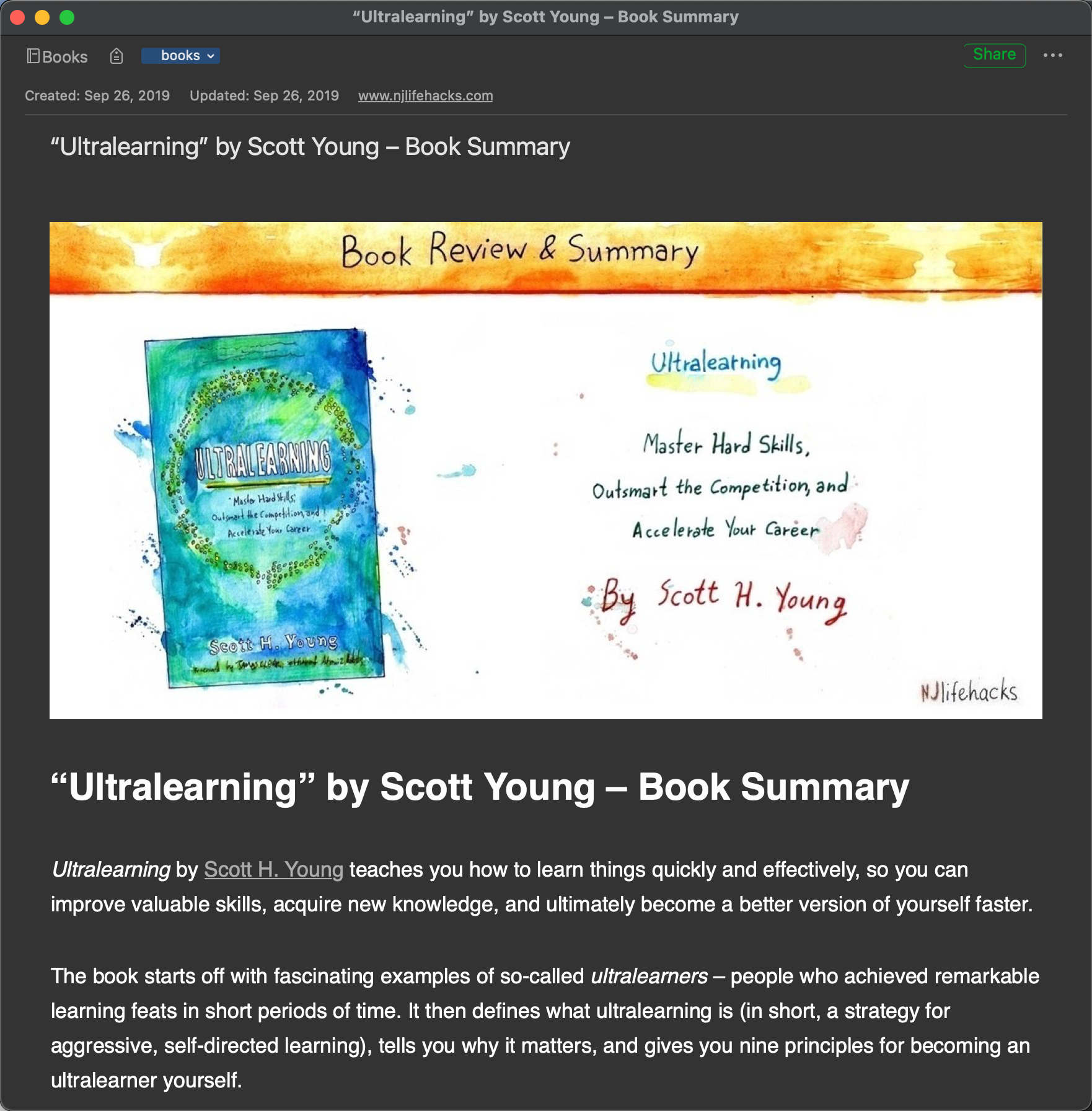
Is it the same as writing my own notes? No, but it is good enough.
Reflect, Review, and Resurface
So you’ve read a book or attended a talk, and you’ve taken notes: now what?
How do you take that mind map, typed note, chicken scratch, or beautiful sketch note and turn it into something actionable? How do you extend the life of your new knowledge and give yourself a chance to apply it later when it is meaningful to you, even if it isn’t right now?
Here’s the thing: you might read something that is not actionable at this stage of your life or career, but it may be later!
So there are two main goals here:
- Make sure you’ve captured anything actionable to your trusted system.
- Have a repeatable, easy schedule to resurface and review your notes.
Before joining the AE team, I was trying to establish my reading ritual and patterned it after this article: How to Effectively Read and Implement Books.
I adapted the schedule in that article to this. Once I finish a book, I add entries in my task manager to review my notes after:
- 3 days — Purpose: to pull out any action items and make sure they are captured. I don’t read my notes in-depth, just skim them over.
- 3 weeks — Purpose: To enhance remembering the notes when the memory is slipping away.
- 3 months — Purpose: Same thing. Remember and review, with the perspective of a bit of distance.
- 1 year — Purpose: Now we have a lot of distance! Let’s revisit, shall we?
- 2 years — Purpose: The “oh yeah, I forgot about that book!” review. Having it pop up in your task manager is a nice surprise, like seeing an old photo.
- 4 years— Purpose: My life and career have probably changed quite a bit in 4 years. Do these notes spark anything new?
I’ve been doing this for 5 or 6 years now, and it is so powerful when that 4-Year review task pops up in OmniFocus.
Here’s an example of my task manager when I finish a book:
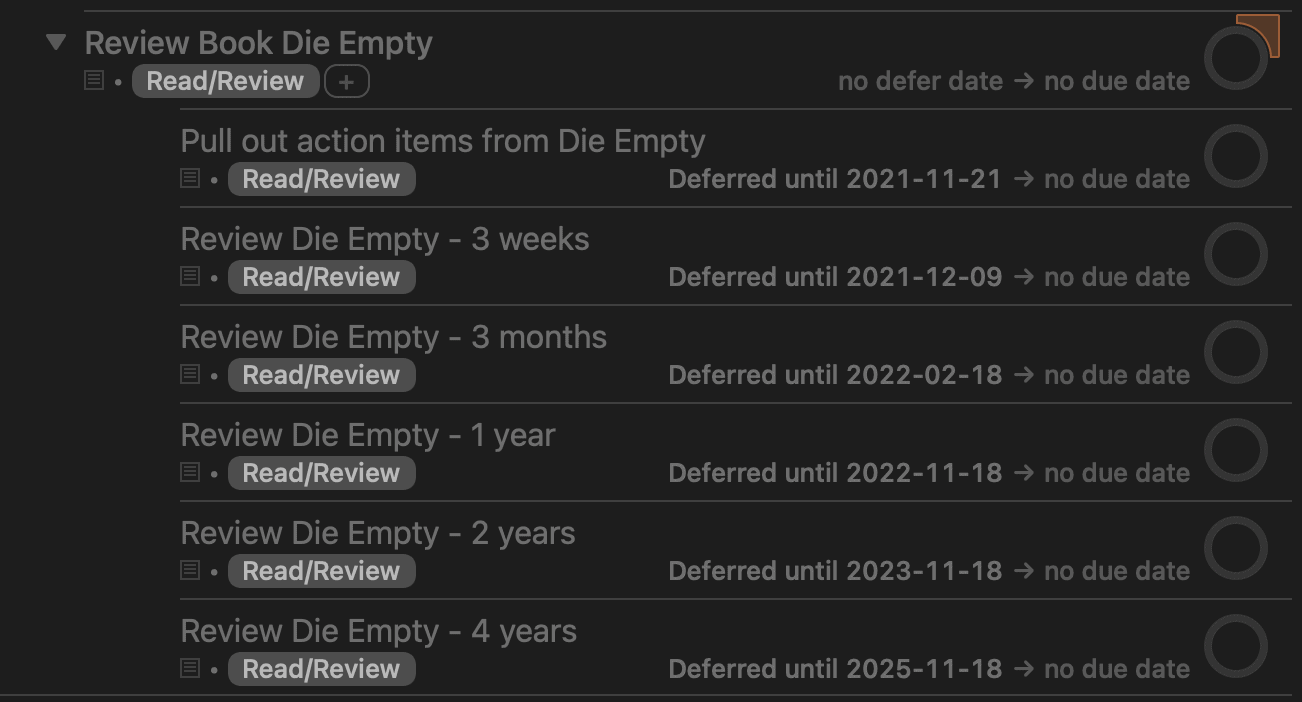
To make it easier to review, each task will include a link to the appropriate Evernote note.
Bonus: My OmniFocus Note Review Shortcut
This will only be useful for the Venn diagram of people who use OmniFocus and iOS, but I use this Shortcut on iOS to create my OmniFocus tasks. I run it on my iOS device, and it will create all the tasks for me.
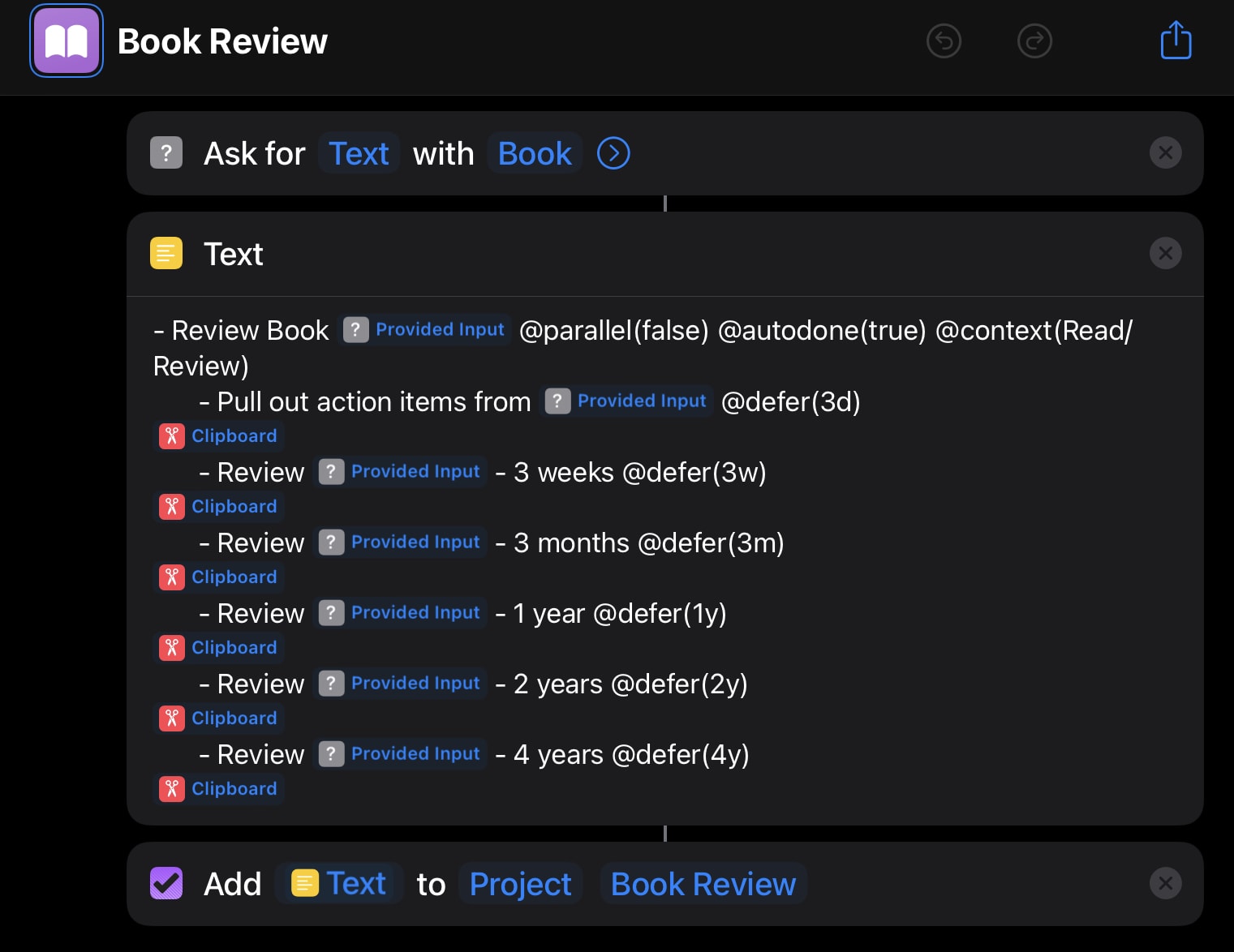
If you want to try it out for yourself, here is an iCloud link you can use.
Just be aware:
- You need to create a Project called Book Review first.
- It adds whatever you have on your clipboard to the Note of each task. Make sure you have the link to your notes on your clipboard first before running
Whatever you do, just read
I developed and iterated this system over many years, and it works for the way my brain works. If you are just starting with a read-and-review system, you don’t need to go quite this far if you don’t want to.
The key things are:
- Have an easy way to capture books you want to read
- Have an easy way to take notes, and refer to those notes later
- Have an easy way to pull out action items from those notes, and make sure to refer to those notes periodically over time to review and refresh.

So you always listen to audiobooks in the car, and not podcasts? The car is when I listen to you!
Listening to Thanh and I takes priority, clearly! 😂
Yep, I listen to audiobooks in the car and podcasts when I am out for a walk, etc. But whatever works for you!
Thanks for the very useful article. I look forward to trying out many of your ideas.